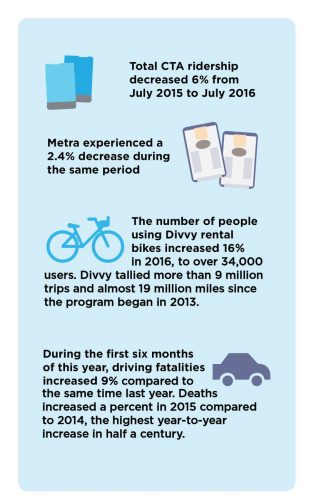Traffic inched at a snail’s pace along the packed highway as Amanda Alba and her sister drove to their classes at DePaul from the suburb of Oak Lawn. The car ahead moved up a few feet, then stopped. Then moved, then stopped. Alba’s sister was asleep in the passenger seat, her head bobbing with the wake of the car. Some tune played over the radio. About halfway through their typical hour-long commute, Alba was, typically, bored to death.
Still aware, Alba noticed a massive truck in the lane next to her. She thought nothing of it. But then the towering beast began to merge into Alba’s lane, right on top of them.

Reacting fast, Alba stepped on the pedal, her heart pounding. With a growl, her car lunged forward, barely missing the truck’s front wheels. A loud blast from the truck’s horn followed. Her sister was now wide awake, a surprised look on her face. Looking through her rearview mirror, Alba noticed the driver’s accusing stare.
“It was this huge, huge truck and this little tiny car,” Alba said. “They just don’t move for you.”
Alba had been driving to class for a couple months. Even though she and her sister came inches from getting hit a truck, she feels like it’s worth it. She decided to make the switch from Metra and CTA because bills were adding up: Metra alone costs $200 a month, and she doesn’t get a discount on as a student, plus the Ventra fees included in her DePaul tuition. Anyway, gas is cheap these days.
Many in Chicago seem to be in the same situation. Total CTA ridership decreased 6 percent from July 2015 to July 2016, and Metra experienced a 2.4 percent decrease during the same period. DePaul students are not isolated from these changes: many students commute from the suburbs, and find driving simply easier than dealing with public transit.
The CTA attributes the change to the cheap price of gas, a product of America’s bolstered fracking industry and the flooding of the oil market by Persian Gulf monarchies. Going with the cheaper alternative, Chicagoans are increasingly putting aside hefty Metra and CTA tickets and instead filling up the gas tank.
About a year ago, Alba was one of those who used public transit. Waking up hours before the start of class, she and her sister would hitch a ride with their parents to the Metra stop in Oak Park. With their Metra cards in hand, they hopped on one of the train’s two levels.
The belly of the Metra trains resembled that of any Amtrak or passenger train: two neat rows, two pairs of seats in each aisle. Alba and her sister would pop onto one of the cushioned seats. The train would eventually lurch forward, and soon after the conductor would come by to scan tickets. Everyone was seated, and quiet. Alba didn’t have to worry about a thing.
After about a half hour passed, Alba and her sister would arrive at Union Station, the beehive of Chicago’s public transit. Getting off the Metra train, they would walk a little further and hop on board one of the CTA’s ‘L’ trains.
People were crammed everywhere: sitting down, standing up. Elbows, hands, a jutting arm. Loud conversations over the phone. Sometimes the smell of urine from someone on the other side of the car. No room to maneuver.
Because of the cost, the crowds and the travel time, Alba decided she had had enough of Metra and CTA. She purchased a car — her sister got their parents’ old car, to her disgust — and started to drive to school every day. Some days the drive takes about 25 minutes, while on others, during the frenzied rush hours, it can take about an hour. Compared to costs for public transit, Alba pays about $300 a year for parking, plus gas. Alba figures she saves handsomely.
But the last thing the City of Chicago wants is for Chicagoans to ditch public transit for cars. With congested highways and streets causing delays for everyone, Mayor Rahm Emanuel has been pushing for change. He figures a faster ‘L’ network and extensive and safe bike trails will encourage Chicagoans to travel by public transit and bicycle.
There are still many who have chosen to stick with public transit.
Richard Litecki began to use Metra and CTA this year to get to his classes at DePaul. He saves a handful on the gas and parking tickets he’d have to buy, while the commute from Westmont takes about the same time. Most importantly, though, Litecki gets to avoid traffic.
When Litecki studied at the College of DuPage, he would have to drive about 30 minutes there, and then putter about for another 20 minutes finding a place to park. In between, Litecki dodged minivans shooting from alleyways and lowriders sailing through red lights.
“I hate traffic,” Litecki said. “I don’t like dealing with it. I get angry at myself.”
That’s really why he takes public transportation, Litecki said. He quickly added, “I’m not a crazy driver or anything.”

